
| Kingdom: |
Animalia |
| Phylum: |
Chordata |
| Class: |
Mammalia |
| Order: |
Carnivora |
| Family: |
Felidae |
| Genus: | Felis |
| Species: |
F. silvestris |
| Subspecies: | F. s. catus |
(Linnaeus, 1758)
|
From Wikipedia the free encyclopedia, by MultiMedia |
|
?
Cat
Conservation status: Domesticated
|
||||||||||||||||
|---|---|---|---|---|---|---|---|---|---|---|---|---|---|---|---|---|
 |
||||||||||||||||
| Scientific classification | ||||||||||||||||
|
||||||||||||||||
|
Trinomial name
|
||||||||||||||||
| Felis silvestris catus (Linnaeus, 1758) |
||||||||||||||||
|
|
The cat, also called the domestic cat or house cat, is a small feline carnivorous mammal of the subspecies Felis silvestris catus. Its most immediate pre-domestication ancestor is the African wild cat, Felis silvestris lybica. The cat has been living in close association with humans for at least 3,500 years; the Ancient Egyptians routinely used cats to keep mice and other rodents (mostly rats) away from their grain (and also believed that cats were sacred to the goddess Bastet). The history of the domestic cat may stretch back even further, as 8,000-year-old bones of humans and cats were found buried together on the island of Cyprus[3].
A group of cats is referred to as a clowder, while a male cat is called a tom, and a female is called a queen or quean. An immature cat is called a kitten (which is also an alternate name for young rats, rabbits, hedgehogs, beavers, and squirrels). A cat whose ancestry is formally registered is called a purebred cat, a pedigree cat, or a show cat (although not all show cats are pedigree or purebred). In strict terms, a purebred cat is one whose ancestry contains only individuals of the same breed. A pedigree cat is one whose ancestry is recorded, but may have ancestors of different breeds.
Purebreds are less than one percent of the total feline population; cats of mixed ancestry are referred to as domestic longhairs and domestic shorthairs or commonly as random-bred, moggies, mongrels, mutt-cats or alley cats. The ratio of pedigree/purebred cats to random-bred cats varies from country to country.
There are dozens of breeds of domestic cats, some hairless or tailless, and they exist in a variety of different colors including multicolored. They are skilled predators and have been known to hunt over one thousand different species for food. They are also intelligent animals: some are able to manipulate simple mechanisms such as lever-handled doors and flush toilets. They communicate by calling ("meow"/"miaou"), purring, hissing, and gesturing. Because the domestication of the cat is relatively recent, cats may also still live effectively in the wild, often forming small colonies. The cat's association with humans leads it to figure prominently in the mythology and legends of several cultures, including the ancient Egyptians, Vikings, and Chinese.
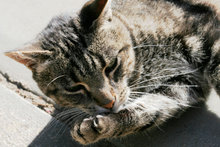 A cat grooming itself.
A cat grooming itself.
Cats typically weigh between 2.5 and 7 kg (5.5–16 lb); however, some breeds, such as the Maine Coon can exceed 11.3 kg (25 pounds). Some have been known to reach up to 23 kg (50 lb), due to overfeeding. This is very unhealthy for the cat, and should be prevented through diet and exercise (playing), especially for cats living exclusively indoors.
In captivity, indoor cats typically live 15 to 20 years, though the oldest-known cat lived to age 36.[4] Domestic cats tend to live longer if they are not permitted to go outdoors (reducing the risk of injury from fights or accidents) and if they are spayed or neutered. Spaying and neutering a cat also decreases the risk of testicular and ovarian cancer, and female cats spayed before their first heat or litter benefit from reduced risk of mammary cancer.[5] Feral cats living in modern urban environments often live only two years, or less. Feral cats in maintained colonies can live much longer; the British Cat Action Trust reported a 19-year-old feral female. The oldest feral cat was Mark who was maintained by the British charity Cats Protection and who reached 26 years of age.
Thirty-two individual muscles in the ear allow for a manner of directional hearing; [6] the cat can move each ear independently of the other. Thus a cat can move its body in one direction and point its ears in quite another direction (such as pointing backward toward its owner). Most cats have straight ears pointing upward. Unlike dogs, flap-eared breeds are extremely rare. (Scottish Folds are one such exceptional genetic mutation.) When angry or frightened, a cat will lay its ears back, to accompany the growling or hissing sounds it makes. Cats conserve energy by sleeping more than most animals, especially as they grow older. Daily durations of sleep are various, usually 12–16 hours, with 13–14 being the average. Some cats can sleep as much as 20 hours in a 24-hour period. The term cat nap refers to the cat's ability to fall asleep for a brief period; someone who nods off for a few minutes is said to be "taking a cat nap".
Cats' temprament can vary depending on the breed and socialization. Shorter haired cats tend to be skinnier and more active, while cats with longer hair tend to be heavier and less active.
The normal body temperature of a cat is between 38 and 39 °C (101 and 102.2 °F).[7] A cat is considered febrile if it has a temperature of 39.5 °C (103 °F) or greater, or hypothermic if less than 37.5 °C (100 °F). Comparatively, humans have a normal temperature of approximately 37 °C (97 to 100 °F). A domestic cat's normal heart rate ranges from 140 to 220 beats per minute, and is largely dependent on how excited the cat is. For a cat at rest, the average heart rate should be between 150 and 180 bpm, depending upon level of activity.
A popular belief holds that cats always land on their feet. They do usually, but not always. During a fall, a cat can reflexively twist its body and right itself using its acute sense of balance and flexibility. [8] It always rights itself in the same way, provided it has the time to do so during a fall. Certain breeds that don't have a tail are a notable exception, since a cat moves its tail and relies on conservation of angular momentum to set up for landing.
Cats, like dogs, are digitigrades: they walk directly on their toes, the bones of their feet making up the lower part of the visible leg. They are capable of walking very precisely, placing each hind paw directly in the print of the corresponding forepaw, minimising noise and visible tracks.
Like many predators, cats have retractable claws. This is actually a misnomer because in their normal, relaxed position the claws are sheathed with the skin and fur around the toe pads. This is done to keep the claws sharp by preventing wear from contact with the ground. It is only by stretching, such as swatting at prey, that the connecting tendons are pulled taut, forcing the claws to extend. Thus extending the claws is an involuntary action.
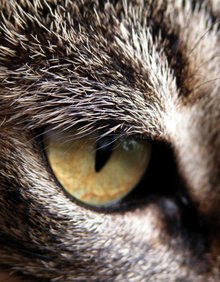 A close-up of a cat's eye.
A close-up of a cat's eye.
Measuring the senses of any animal can be difficult, because there is usually no explicit communication (e.g., reading aloud the letters of a Snellen chart) between the subject and the tester.
While a cat's senses of smell and hearing may not be as keen as, say, those of a mouse, they are superior in many ways to those of humans. These along with the cat's highly advanced eyesight, taste, and touch receptors make the cat extremely sensitive among mammals.
Testing indicates that a cat's vision is superior at night in comparison to humans, and inferior in daylight. Cats, like dogs, have a tapetum lucidum that reflects extra light to the retina. While this enhances the ability to see in low light, it appears to reduce net visual acuity, thus detracting when light is abundant. In very bright light, the slit-like iris closes very narrowly over the eye, reducing the amount of light on the sensitive retina, and improving depth of field. The tapetum and other mechanisms give the cat a minimum light detection threshold up to 7 times lower than that of humans. Variation in color of cats' eyes in flash photographs is largely due to the interaction of the flash with the tapetum.
Average cats have a visual field of view estimated at 200°, versus 180° in humans, with a binocular field (overlap in the images from each eye) narrower than that of humans. As with most predators, their eyes face forward, affording depth perception at the expense of field of view. Field of view is largely dependent upon the placement of the eyes, but may also be related to the eye's construction. Instead of the fovea which gives humans sharp central vision, cats have a central band known as the visual streak. Cats can apparently differentiate among colors, especially at close range, but without appreciable subtlety.
Cats have a third eyelid, the nictitating membrane, which is a thin cover that closes from the side and appears when the cat's eyelid opens. This membrane partially closes if the cat is sick; although in a sleepy, content cat this membrane is often visible. If a cat chronically shows the third eyelid, it should be taken to a veterinarian.
Humans and cats have a similar range of hearing on the low end of the scale, but cats can hear much higher-pitched sounds, even better than dogs. Cats can hear 2 octaves higher than humans, and one-half octave higher than dogs. When listening for something, a cat's ears will swivel in that direction; a cat's ear flaps (pinnae) can independently point backwards as well as forwards and sideways to pinpoint the source of the sound. Cats can judge within three inches (7.5 cm) the location of a sound being made one yard (approximately one meter) away.
A domestic cat's sense of smell is about 14 times stronger than a human's. Cats have twice as many smell-sensitive cells in their noses as people do, which means they can smell things we are not even aware of. Cats also have a scent organ in the roof of their mouths called the vomeronasal, or Jacobson's, organ. When a cat wrinkles its muzzle, lowers its chin, and lets its tongue hang a bit, it is opening the passage to the vomeronasal. This is called gaping. Gaping is the equivalent of the Flehmen response in other animals, such as dogs and horses.
 A cat using its senses for exploration
A cat using its senses for exploration
Cats generally have about a dozen whiskers in four rows on each upper lip, a few on each cheek, tufts over the eyes and bristles on the chin. Whiskers may also be found on the cat's "elbows." The Sphynx (a nearly hairless breed) may have full length, short, or no whiskers at all.
Whiskers (technically called vibrissae) can aid with navigation and sensation. Whiskers may detect very small shifts in air currents, enabling a cat to know it is near obstructions without actually seeing them. The upper two rows of whiskers can move independently from the lower two rows for even more precise measuring.
It is thought that a cat may choose to rely on the whiskers in dim light where fully dilating the pupils would reduce its ability to focus on close objects. The whiskers also spread out roughly as wide as the cat's body making it able to judge if it can fit through an opening.
Whiskers are also an indication of the cat's attitude. Whiskers point forward when the cat is inquisitive and friendly, and lie flat on the face when the cat is being defensive or aggressive.
According to National Geographic (December 8), cats cannot taste sugary foods due to a faulty sweet receptor gene. Some scientists believe this is related to the cat's diet being naturally high in protein, though it is unclear whether it is the cause or the result of it.
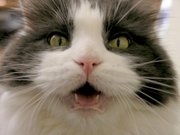 A cat vocalizing
A cat vocalizing
The unique sound a small cat makes is written onomatopoeically as "meow" in American English; "meow" or "miaow" in British English; "miaou" or "miaw" in French; "miao" in Mandarin Chinese and Italian; "miau" in German, Spanish, Finnish, Lithuanian, Polish, Croatian, Romanian and Portuguese; "miau" or "מיאו" in Hebrew;"miyav" in Turkish; "mjäu" in Estonian; "mowa'a" in Arabic; "nyaa" or "nyan" in Japanese; "meong" or "ngeong" in Bahasa Indonesia; "ngiau" in Malay; "yaong" or "nyaong" in Korean; and various ways in other languages. The sound of an increasingly annoyed cat is transcribed in James Joyce's Ulysses as "mkgnao", "mrkgnao" and "mrkrgnao" [9], and the sound made by Pixel, the title character of Robert A. Heinlein's The Cat Who Walks Through Walls, was written as "blert", while the sound made by Bill the Cat in Berkeley Breathed's comic strip Bloom County was generally described as "ack". The cat's pronunciation of this call varies significantly depending on meaning. Usually cats call out to indicate pain, request human attention (to be fed or played with, for example), or as a greeting. Some cats are very vocal, and others rarely call out. Cats are capable of about 100 different vocalisations, compared to about 10 for dogs.
A kitten's call first starts out as a high-pitched squeak-like sound when very young, and then deepens over time. Some cats, however, do not exercise their voices a lot, so their call may remain similar to that of a kitten through adulthood.
Cats can also produce a purring noise that typically indicates that the cat is happy, but also can mean that it feels distress. Cats purr among other cats—for example, when a mother meets her kittens. Until recently, there were many competing theories to explain how cats purr, including vibration of the cat's false vocal chords when inhaling and exhaling, the sound of blood hitting the aorta, vibration of the hyoid apparatus, or resonation directly in the lungs. Currently, though, it is believed that purring is a result of rhythmic impulses to the cat's larynx.
It is possible for a cat to call out and purr simultaneously, although this is typical only in very vocal cats. In addition to purring, happy cats may blink slowly or partially close their eyes to break any possible stares and communicate their ease in the situation. However, purring may also be a way for the cat to calm itself down. For example, cats have been known to purr when hurt.
Most cats growl or hiss when angered or in danger. Some may engage in nipping behavior or batting with their paws, either with claws extended or retracted. With cats who are improperly socialised and do not know their own strength, this can result in inadvertent damage to human skin. Cat scratches can easily become infected, and in extreme cases can result in cat scratch fever.
Cats are also known to make chirping noises when observing prey, or as a means of expressing interest in an object to nearby humans. When directed at out-of-reach prey, it is unknown whether this is a threatening sound, an expression of frustration, or an attempt to replicate a birdcall (or replicate the call of a bird's prey, for example a cicada). Since this feline expression often involves a mouth movement similar to the one they would use to kill their prey (their "killing bite"), they may be trying to practice this mouth movement in anticipation.
When passing solid waste, cats, like many types of predators, release from anal glands a small amount of liquid that scents their feces, to mark their territory. These scent-producing anal sacs are found in all predators; those of the skunk are used for self-defense, for example. During moments of excitement or other strong emotions, a cat's anal sac may discharge, releasing a foul-smelling brown liquid. Anal irritation, possibly shown by the cat rubbing its bottom on the floor and frequent licking of the area, can be a sign that the cat's anal sacs are not being emptied when waste passes [10]. Although this condition can be treated through the addition of a small amount of bran to each meal, it may require veterinary attention. Shorthair cats are more prone to this problem.
Cats will twitch the tips of their tails when hunting or angry, while larger twitching indicates displeasure. A tail held high is a sign of happiness, while half-raised shows less pleasure, and unhappiness is indicated with a tail held low. A scared cat may puff up its tail and the hair along its back and turn its body sideways to a threat in order to increase its apparent size. Tailless cats, such as the Manx (cat), who possess only a small stub of a tail move the stub around as though they possessed a full tail, though it is not nearly as communicative as that of a fully tailed cat. Touching noses is a friendly greeting for cats, while a lowered head is a sign of submission.
When cats are happy, they are known to paw their owners, or that on which they sit, with a kneading motion. Cats often use this action alongside purring to show contentment and affection for their owners. The action is often referred to as paddy-pawing, making muffins or treading paws. It is instinctive to cats, and they use it when they are young to stimulate the mother cat's nipple to release milk during nursing. As a result, cats that are hand-raised by humans may lack this reflex. Pawing is also a way for cats to mark their territory. The scent glands on the underside of their paws release small amounts of scent onto the person or object being pawed, marking it as "theirs" in the same way they would urinate to mark their territory.
Relative to size, domestic cats are very effective predators. They ambush and dispatch vertebrate prey using tactics similar to those of leopards and tigers by pouncing; they then deliver a lethal neck bite with their long canine teeth that severs the victim's spinal cord, or asphyxiate it by crushing the windpipe.
The domestic cat can hunt and eat about one thousand species—many big cats will eat fewer than 100. Although, theoretically, big cats can kill most of these species as well, they often do not due to the relatively low nutritional content that smaller animals provide. An exception is the leopard, which commonly hunts rabbits and many other smaller animals.
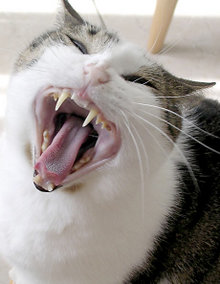 A cat yawning, showing characteristic canine teeth.
A cat yawning, showing characteristic canine teeth.
Cats have highly specialized teeth and a digestive tract suitable to the digestion of meat. The premolar and first molar together compose the carnassial pair on each side of the mouth, which efficiently functions to shear meat like a pair of scissors. While this is present in canines, it is highly developed in felines. The cat's tongue has sharp spines, or papillae, designed to retain and rip flesh from a carcass. These papillae are small backward-facing hooks that contain keratin and assist in their grooming. Unlike most carnivores, cats eat almost no vegetable matter apart from that found in the digestive tracts of their prey. Whereas bears and dogs commonly supplement their diet of meat with fruits, berries, roots, and honey when they can get them, cats feed exclusively on meat, usually freshly killed. Cats, including the great cats, have a genetic anomaly that prevents them from tasting sweetness [11], which is probably related to their meat-only habits.
In captivity, cats cannot be adapted to an unsupplemented vegetarian diet because they cannot synthesize all the amino acids they need from plant material. Specifically this applies to taurine, the absence of which causes the cat's retina to slowly degenerate, causing eye problems and (eventually) irreversible blindness. This condition is called central retinal degeneration (CRD). Cow's milk is a poor source of taurine and adult cats are generally lactose intolerant. Lactose-free milk is perfectly safe, but still not a substitute for meat. This contrasts with domesticated dogs, which commonly are fed a mixture of meat and vegetable products and have been adapted in some cases to a vegetarian diet. Despite this, however, the majority of brand-name cat foods are primarily grain based, often containing large amounts of corn or rice and supplemented with meats and essential vitamins. Some vegetarian owners feed their cats a vegetarian diet containing supplemental taurine.
Cats are also known to munch on grass, leaves, shrubs and houseplants. They do not eat a lot in one sitting, but prefer to have it as a snack. Eating vegetation in this way may aid the cat's digestive system and can prevent hairballs. [12].
Cats can be fussy eaters. This mostly happens when the vomeronasal, or Jacobson's, organ becomes sensitized to a specific food, at which point the cat will reject any food that doesn't fit the pattern it is expecting. Additionally, cats have been known to develop a fondness for "people food" such as barbecued chicken, bread, french fries, pepperoni pizza, ice cream, tomato soup, carrot juice, olives, and carnitas burritos, as well as cat diet exotica such as corn kernels and diced cantaloupe. Many "people foods" are not good for cats; chocolate, for example, can be fatal due to the theobromine found in chocolate.
Domestic cats, especially young ones, are known for their love of string play. Many cannot resist a dangling piece of string, or a piece of rope drawn randomly and enticingly across the floor. This notorious love of string is often depicted in cartoons and photographs, which show kittens or cats playing with balls of yarn. This propensity is probably related to their hunting instinct. However, string is more often being replaced with a red dot laser pointer. This is because, if the string is ingested, it can be caught in the cat’s stomach or intestines causing illness or, in extreme cases, death. Some people discourage the use of laser pointers for play with pets, however, because of the risk of eye damage and the loss of satisfaction (especially for cats) associated with the successful capture of prey.
Because of their small size, domestic cats pose almost no danger to humans—the only hazard is the possibility of infection (or, rarely, rabies) from a cat bite or scratch.
Cats can be destructive to ecosystems in which they are not native and whose species did not have time to adapt to their introduction. In some cases, cats have contributed to or caused extinctions — for example, see the case of the Stephens Island Wren.
 A cat litter box.
A cat litter box.
Cats are known for their cleanliness. They groom themselves by licking their fur. Their saliva is a powerful cleaning agent, but it can provoke allergic reactions in humans. Some people who are allergic to cats - typically manifested by hay fever, asthma or a skin rash - quickly acclimate themselves to a particular animal and live comfortably in the same house with it, while retaining an allergy to cats in general. Many cats also enjoy grooming humans or other cats. Some cats occasionally regurgitate hair balls of fur that have collected in their stomachs as a result of their grooming. Longhair cats are more prone to this than shorthairs. Hairballs can be prevented with certain cat foods and remedies that ease elimination of the hair. Cats expend nearly as much fluid grooming as they do urinating.
Indoor cats may be provided a litter box containing sand or similar commercial material (litter). This arrangement serves the same purpose as a toilet for humans. It should be cleaned daily and changed often (depending on the number of cats in a household and the type of litter—clumping litter stays cleaner longer, but has been reported to cause health problems in some cats. [13]) A litterbox is recommended for indoor-outdoor cats as well. Litterboxes may pose a risk of toxoplasmosis transmission to susceptible pregnant women and immuno-compromised individuals. Transmission risk may be reduced by daily litterbox cleaning.
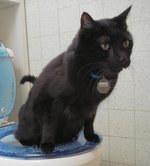 Toilet-trained cat.
Toilet-trained cat.
In addition, some cats may be toilet trained, eliminating the litterbox and its attending expense and odor. Training involves two or three weeks of incremental moves, such as moving and elevating the litterbox until it is near the toilet. For a short time, an adapter, such as a bowl or small box, may be used to suspend the litter above the toilet bowl. When training is complete, the cat uses the toilet by perching over the bowl. [14]
Indoor cats will also benefit from being provided with a scratching post so they are less likely to ruin furniture with their claws.[15] Nails can be trimmed, but care should be taken to avoid cutting a vein in the quick of the claw.
Some cat owners choose to have their cat declawed (onychectomy). This major surgery removes the tip of each digit (from the first knuckle out) of the cat's forepaws. Some people are opposed to declawing, claiming it is inhumane. Declawing is not a simple procedure; serious complications can arise, such as an increased risk of infections, or life-long discomfort in the cat's paws. This operation is rare outside of North America. In Germany and Switzerland, declawing cats is explicitly forbidden by the laws against cruelty to animals.[16] In many other European countries, it is also forbidden under the terms of the European Convention for the Protection of Pet Animals, unless "a veterinarian considers [such] non-curative procedures necessary either for veterinary medical reasons or for the benefit of any particular animal". [17]
Where it is legal, some cat veterinarians refuse to do this type of surgery because it deprives the cat of its main defense ability, although cats usually learn to donkey kick or rake with their hind claws in defense. Other experts mention difficulties with the cat's typical stretching and exercise habits, which can lead to muscle atrophy. Some doctors believe that a loss of the cat's claws causes a loss of its ability to balance on thin objects, such as rails or balconies. Declawing surgery requires anesthesia, which carries with it a small risk of death. Additionally, some experts believe that declawed cats are more inclined to bite. If a cat is not declawed at an early age, it becomes too dangerous to declaw them when they are older. However, many American cats are still declawed, often when the owner finds that it is the only option for keeping the cat (sometimes it is mandated by landlords). Some cats that are not declawed and cannot be retrained are either abandoned or turned in to animal shelters, where they may be euthanized. In Britain, where the prevailing style of ownership is indoor/outdoor, shelters find it difficult to rehome imported cats that had previously been declawed. One popular, relatively inexpensive alternative to declawing is the application of vinyl nail caps that are affixed to the claws with nontoxic glue, requiring periodic replacement when the cat sheds its claw sheaths (usually every four to six weeks).
The wild cat, ancestor of the domestic cat, is believed to have evolved in a desert climate, as evident in the behavior common to both the domestic and wild forms. Wild cats are native to all continents other than Australasia and Antarctica. Their feces are usually dry, and cats prefer to bury them in sandy places. They are able to remain motionless for long periods, especially when observing prey and preparing to pounce. In North Africa there are still small wildcats that are probably related closely to the ancestors of today's domesticated breeds.
Cats enjoy heat and solar exposure, often sleeping in a warm area during the heat of the day. Cats like to be a lot warmer than humans do. People start to feel uncomfortable when their skin's temperature gets higher than about 44.5 °C (112 °F), but cats don't start to show signs of discomfort until their skin reaches about 52 °C (126 °F).
Being closely related to desert animals, cats can withstand the heat and cold of a temperate climate, but not for long periods. Although certain breeds such as the Norwegian Forest Cat and Maine Coon have developed more protection than others, they have little resistance against fog, rain and snow and struggle to maintain their 39 °C (102 °F) body temperature when wet. Most cats dislike immersion in water, but one exception is the Turkish Van cat. If a cat is continually exposed to water from a very young age, often it will develop a fondness for it; however, this rarely if ever occurs naturally.
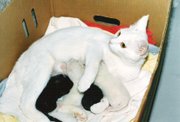 Four kittens being nursed.
Four kittens being nursed.
Cats are seasonally polyestrous, which means they may have many heat periods over the course of a year. A heat period lasts about 4 to 7 days if the female is bred; if she is not, the heat period lasts longer and recurs at regular intervals.
The male cat's penis has spines which point backwards. Upon withdrawal of the penis, the spines rake the walls of the female's vagina. The female needs this stimulation for ovulation to begin. Because of this, females are rarely impregnated by the first male with which they mate. Furthermore, cats are superfecund; that is, a female may mate with more than one male when she is in heat, meaning different kittens in a litter may have different fathers.
The gestation period for cats is approximately 60 days. The size of a litter averages three to five kittens, with the first litter usually smaller than subsequent litters. Kittens are weaned at between six and seven weeks, and cats normally reach sexual maturity at six months (females) to seven months (males).
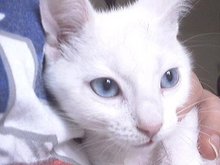 Blue-eyed cats with white fur have a higher genetic incidence of deafness.
Blue-eyed cats with white fur have a higher genetic incidence of deafness.
Completely white cats (not due to albinism, but white because of the dominant epistatic white (W) gene) with two blue eyes have a forty percent probability of being born deaf.
The deafness is an effect of the W gene. This gene produces a white coat because it completely masks any other color or pattern the cat has. Blue irises can result, and they are linked to deafness. [18] Any cat that receives even one W from one parent may exhibit this. Blue eyes can also result from the form of albinism characteristic of the siamese breed; white cats from this genetic background, sometimes called Foreign whites or Oriental Shorthairs may not have a problem with deafness, but it can happen if the cat inherits the W gene. This also occurs with dogs if they have white coat and blue eyes, and in the case of dogs, it can be equally common for them to be born blind. [19] However, blindness in cats has not found to be associated with the W gene. [20] Often, blue eyes will lack a tapetum lucidum and thus will not reflect like colored cat eyes. This may diminish the cats' visual acuity, but the extent is not known. Humans with common albinism, white skin and blue eyes generally suffer from visual problems, but in Tietz syndrome they suffer from deafness.
Around 5% of all cats are completely white, of which 10%–20% are deaf. Very few survive in the wild because of all the hazards that they cannot avoid as easily as other cats would in the same situation. Many people believe that deaf white cats should not be used for breeding as it is not ethical to propagate such a disability, and instead deaf cats should be spayed or neutered to avoid passing the trait to their offspring. [21] Some breeds however, such as the Turkish Angora are based on all white cats and produce a higher percentage of deaf cats as a results. It was not until recently that colored Turkish Angoras were allowed to be shown, making deafness an issue in that breed. Apart from the Turkish Angora, there are also many non-pedigree white cats that have odd eyes, i.e. one blue eye and one amber eye.
Like some other domesticated animals, cats live in a mutualistic arrangement with humans. Cats, however, have done so for a much shorter time than almost all other domesticated animals, and the degree of domestication of cats is somewhat disputed. Since the benefit of removing rats and mice from humans' food stores outweighed the cost of allowing a formerly wild animal to enjoy the relative safety of a human settlement, the relationship between cat and human flourished. Unlike the dog, which also kills rodents, the cat did not eat grains, fruits, or vegetables. A cat that is good at hunting rodents is referred to as a mouser.
The venerable simile "like herding cats" refers to the seeming intractability of the ordinary house cat to be trained in the manner of the dog. Despite occasional cohabitation in colonies, cats are lone hunters. It is no coincidence that cats are also "clean" animals, the chemistry of their saliva, expended in frequent grooming, acting as a natural deodorant. The "purpose" of this cleanliness is to help hide the cat's presence while stalking prey. A dog's odor, on the other hand, is an advantage, for a dog is a pack hunter; part of the pack stations itself upwind, and its odor drives prey towards the rest of the pack stationed downwind. This requires a cooperative effort, which in turn requires communications skills. No such communications skills are required of the lone hunter. Thus, communicating with such an animal is problematic, and cats in particular are labelled as opaque or inscrutable, if not obtuse, as well as aloof and self-sufficient. However, cats can be very affectionate towards their humans, especially if they imprint on them at a very young age and are treated with consistent affection.
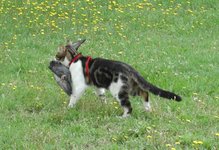 Cat catching a pigeon.
Cat catching a pigeon.
Human attitudes toward cats vary widely. Some humans keep cats for companionship as pets. Some people (known as cat lovers) go to great lengths to pamper their cats, sometimes treating them almost as if they were children. When a cat bonds with its human owner, at times, the cat may display behaviors similar to that of the human. Such behavior may include a trip to the litter box before bedtime and snuggling up close to its companion in bed or on the sofa. Other behaviors could include mimicking sounds of the owner or using certain sounds the cat picks up from the human; sounds representing specific needs of the cat, which the owner would recognize. The cat may also be capable of learning to communicate with the human using non-spoken language or body language such as rubbing for affection (confirmation), facial expressions and making eye-contact with the owner if something needs to be addressed (e.g. finding a bug crawling on the floor for the owner to get rid of). Some owners like to train their cat to perform "tricks" commonly exhibited by dogs such as jumping.
Allergies to cat dander are one of the most common reasons people cite for disliking cats. However, in some instances, humans find the rewards of cat companionship outweigh the discomfort and problems associated with allergies. Many chose to cope with cat allergies by taking prescription allergy medicine and bathing their cats frequently, since weekly bathing will eliminate about 90% of the cat dander present in the environment. Recent studies have indicated the humans who are exposed to cats or dogs within the first year of their lives develop few animal allergies, while most adults who are allergic to animals did not have a cat or a dog as a pet in childhood.
In urban areas, some people find feral and free roaming pet cats annoying and intrusive. Unaltered animals can engage in persistent nighttime calling (caterwauling) and defecation or "marking" on private property. Indoor confinement of pets and TNR (Trap, Neuter, Return) programs for feral cats can help in this situation; some people also use cat deterrents to discourage cats from entering their property.
In rural areas, farms often have dozens of semi-feral cats. Hunting in the barns and the fields, they kill and eat rodents that would otherwise spoil large parts of the grain crop. Many pet cats successfully hunt and kill rabbits, rodents, birds, lizards, frogs, fish, and large insects by instinct, but might not eat their prey. They may even present such victims, dead or maimed, to a beloved owner, perhaps expecting their owner to praise or reward them, or possibly even complete the kill and eat the mouse.
Despite its reputation as a solitary animal, the domestic cat is social enough to form colonies, but does not attack in groups as do lions. Some breeds like bengal, ocicat and manx are very social, but these breeds are exceptions. While each cat holds a distinct territory (sexually active males having the largest territories, and neutered cats having the smallest), there are "neutral" areas where cats watch and greet one another without territorial conflict or aggression. Outside of these neutral areas, territory holders usually vigorously chase away strangers, at first by staring, hissing, and growling, and if that does not work by short but noisy and violent attacks. Fighting cats make themselves look larger by raising their fur and arching their backs. Attacks usually comprise powerful slaps to the face and body with the forepaws as well as bites, but serious damage is rarely done, and usually the loser runs away with little more than a few scratches to the face. Sexually active males may be engaged in many fights over their lives and often have decidedly weathered faces with obvious scars and cuts to the ears and nose. Not only males will fight; females will also fight over territory or to defend their kittens and even neutered cats will defend their small territories vigorously.
![Feral cats are thought to be a major predator of Hawaiian coastal and forest habitats, and are one species among many responsible for the decline of endemic forest bird species as well as seabirds like the Wedge-tailed Shearwater. [1] In one study of 56 cat scats, the remains of 44 birds were found, 40 of which were endemic species. [2]](images/180px-Ff.gif) Feral cats are thought to be a major predator of Hawaiian coastal and forest
habitats, and are one species among many responsible for the decline of endemic
forest bird species as well as seabirds like the Wedge-tailed Shearwater.
[1] In one study of 56 cat scats, the remains of 44 birds were found, 40
of which were endemic species.
[2]
Feral cats are thought to be a major predator of Hawaiian coastal and forest
habitats, and are one species among many responsible for the decline of endemic
forest bird species as well as seabirds like the Wedge-tailed Shearwater.
[1] In one study of 56 cat scats, the remains of 44 birds were found, 40
of which were endemic species.
[2]
Feral cats may live alone, but most are found in large groups called feral colonies with communal nurseries, depending on resource availability. Many lost or abandoned pet cats join these colonies out of desperation. The average lifespan of these feral cats is much shorter than a domestic housecat, which can live an average of sixteen years or more. Urban areas are not native environments to the cat; most domestic cats were artificially selected from cats in desert climates and were distributed throughout the world by humans, but some feral cat colonies are found in large cities, for example, around the Colosseum and Forum Romanum in Rome. Although cats are adaptable, feral felines are unable to thrive in extreme cold and heat, and with a protein requirement of about 90%, few find adequate nutrition on their own in cities. In addition, they have little defense or understanding of the dangers from dogs, coyotes, and even automobiles. However, there are thousands of volunteers and organizations that trap these unadoptable feral felines, spay or neuter them, immunize the cats against rabies and feline leukemia, and treat them with long-lasting flea products. Before release back into their feral colonies, the attending veterinarian nips the tip off one ear to mark the feral as spayed/neutered and inoculated, as these cats will more than likely find themselves trapped again. Volunteers continue to feed and give care to these cats throughout their lives, and not only is their lifespan greatly increased, but behavior and nuisance problems, due to competition for food, are also greatly reduced. In time, if an entire colony is successfully spayed and neutered, no additional kittens are born and the feral colony disappears. Many hope to see an end to urban feral cat colonies through these efforts.
The environmental impact of feral cat programs and of indoor/outdoor cats is a subject of debate. Part of this stems from humane concern for the cats themselves and part arises from concerns about cat predation on endangered species. Nearly all studies agree that abandoned animals lead hard lives. Owners who can no longer keep their cats would do best to give them to friends, rescue organizations, or shelters.
The amount of ecological damage done by indoor/outdoor cats depends on local conditions. The most severe impact occurs with island ecologies. Serious concerns also exist in places such as Florida where housecats are not native, where several small sized endangered species live near human populations, and where the climate allows cats to breed throughout the year. Environmental concerns may be minimal in most of England where cats are an established species and few to none of the local prey species are endangered.
Pet owners can contact veterinarians, ecological organizations, and universities for opinions about whether local conditions are suitable for outdoor cats. Additional concerns include potential dangers from larger predators and infectious diseases. Coyotes kill large numbers of housecats in the Southwestern United States, even in urban zones. FELV (feline leukemia), FIV (feline immunodeficiency virus), or rabies may be present in the area. If faced with conflicting evidence, the safe choice is to keep a cat indoors. Experts recommend a gradual transition to indoor life for cats who are accustomed to going outside.
The domestic cat was named Felis catus by Carolus Linnaeus in his Systema Naturae of 1758. Johann Christian Daniel von Schreber named the wild cat Felis silvestris in 1775. The domestic cat is now considered a subspecies of the wild cat: by the strict rule of priority of the International Code of Zoological Nomenclature the name for the species thus ought to be F. catus since Linnaeus published first. However, in practice almost all biologists use F. silvestris for the wild species, using F. catus only for the domesticated form.
In opinion 2027 (published in Volume 60, Part 1 of the Bulletin of Zoological Nomenclature, 31 March 2003 [22]) the International Commission on Zoological Nomenclature "conserved the usage of 17 specific names based on wild species, which are predated by or contemporary with those based on domestic forms", thus confirming F. silvestris for the wild cat and F. silvestris catus for its domesticated subspecies. (F. catus is still valid if the domestic form is considered a separate species.)
Johann Christian Polycarp Erxleben named the domestic cat Felis domesticus in his Anfangsgründe der Naturlehre and Systema regni animalis of 1777. This name, and its variants Felis catus domesticus and Felis silvestris domesticus, are often seen, but they are not valid scientific names under the rules of the International Code of Zoological Nomenclature.
The list of cat breeds is quite large. Each breed has distinct features and heritage. The owners and breeders of show cats compete to see whose animal bears the closest resemblance to the "ideal" definition of the breed (see selective breeding). Due to common crossbreeding in populated areas, many cats are simply identified as belonging to the homogeneous breeds of domestic longhair and domestic shorthair, depending on their type of fur. In the United Kingdom and Australia, non-purebred cats are referred in slang as moggies (also an archaic slang word for a prostitute, probably referring to a female cat's promiscuous habits). In the United States, a non-purebred cat is sometimes referred to in slang as an alley cat, even if it is not a stray.
Cats come in a variety of colors and patterns. These are physical properties and should not be confused with a breed of cat.
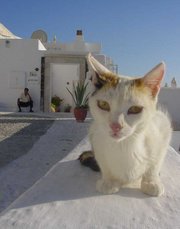 This Greek cat has light fur and green eyes.
This Greek cat has light fur and green eyes.
Household cats are divided into:
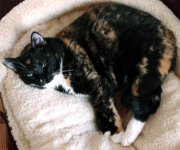 This Calico cat has black-brown-white fur and green eyes.
This Calico cat has black-brown-white fur and green eyes.Main article History of cats
Cats have been kept with humans since at least the days of Ancient Egypt through various cultures. In Ancient Egypt, the cat god, Bast, is a goddess of the home and of the domestic cat, although she sometimes took on the war-like aspect of a lioness. Daughter of the sun god Ra, although sometimes regarded as the daughter of Amun. She was the wife of Ptah and mother of the lion-god Mihos. Her cult was centered on her sanctuary at Bubastis in the delta region, where a necropolis has been found containing mummified cats. Bast was also associated with the 'eye of Ra', acting as the instrument of the sun god's vengeance. She was depicted as a cat or in human form with the head of a cat, often holding the sacred rattle known as the sistrum.
Cats, made by MultiMedia | Free content and software
This guide is licensed under the GNU Free Documentation License. It uses material from the Wikipedia.